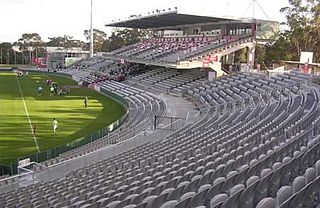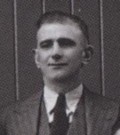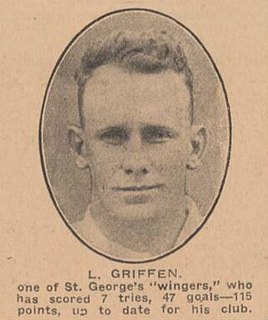
The St. George Dragons is an Australian rugby league football club from St George District in Sydney, New South Wales that played in the top level New South Wales competition and Australian Rugby League competitions from the 1921 until the 1997 ARL season, as well as the unified 1998 National Rugby League season. On 23 September 1998, the club formed a joint venture with the Illawarra Steelers, creating the St. George Illawarra Dragons team which competed in the 1999 NRL season and continues to compete in the league today. As a stand-alone club, it fields teams in the NSWRL underage men's and women's competitions, Harold Matthews Cup, S.G. Ball, and Tarsha Gale Cup.

The Balmain Tigers are a rugby league club based in the inner-western Sydney suburb of Balmain. They were a founding member of the New South Wales Rugby League and one of the most successful in the history of the premiership, with eleven titles. In 1999 they formed a joint venture club with the Western Suburbs Magpies club to form the Wests Tigers for competition in the National Rugby League (NRL). They no longer field any senior teams in the lower divisions. At the time of the joint venture only South Sydney Rabbitohs and the St George Dragons had won more titles than the Tigers.

The Newtown Jets are an Australian rugby league football club based in Newtown, a suburb of Sydney's inner west. They currently compete in the Canterbury Cup NSW competition, having left the top grade after the 1983 NSWRFL season. The Jets' home ground is Henson Park, and their team colours are blue and white.

Jubilee Oval, also known as Kogarah Oval or by its sponsored name Netstrata Jubilee Stadium, is a multipurpose stadium in Carlton, Sydney, Australia. The stadium is mainly used for rugby league and the A-League, and is one of the home grounds of the National Rugby League (NRL) team St. George Illawarra Dragons. The stadium has hosted football matches, including hosting Sydney Olympic FC in the 2003–04 National Soccer League and recently, Sydney FC in the 2018–19, 2019–20 A-League, 2020-21 and 2021-22 due to the rebuild of the Sydney Football Stadium. The Cronulla Sutherland Sharks are temporarily playing at Netstrata Jubilee Stadium during the major redevelopment of their leagues club and stadium.

Leichhardt Oval is a rugby league and soccer stadium in Lilyfield, New South Wales, Australia. It is currently one of three home grounds for the Wests Tigers National Rugby League (NRL) team, along with Campbelltown Stadium and Western Sydney Stadium. Prior to its merger with the Western Suburbs Magpies, it was the longtime home of the Balmain Tigers, who used the ground from 1934–1994 and 1997–1999. It was named after Ludwig Leichhardt.
The 1974 New South Wales Rugby Football League premiership was the 67th season of Sydney's professional rugby league football competition, Australia's first. Twelve teams, including six of 1908's foundation clubs and another six from across Sydney, competed for the J. J. Giltinan Shield during the season, which culminated in a grand final match for the WD & HO Wills Cup between the Eastern Suburbs and Canterbury-Bankstown clubs. This season NSWRFL teams also competed for the inaugural Amco Cup.
The 1961 New South Wales Rugby Football League premiership was the 54th season of the rugby league competition based in Sydney. Ten teams from across the city competed for the J J Giltinan Shield and WD & HO Wills Cup during the season, which culminated in a grand final between St. George and Western Suburbs.
The 1966 New South Wales Rugby Football League premiership was the 59th season of the rugby league competition based in Sydney. Ten clubs from across the city competed for the J.J. Giltinan Shield and the WD & HO Wills Cup during the season, which culminated in a replay of the 1964 grand final between St. George and Balmain.
The 1925 New South Wales Rugby Football League premiership was the eighteenth season of Sydney’s top-level rugby league club competition, Australia’s first. Nine teams from across the city contested during the season, with South Sydney being crowned premiers by finishing on top of the League.
The 1927 New South Wales Rugby Football League premiership was the twentieth season of Sydney's top-level rugby league club competition, Australia's first. Nine teams from across the city contested during the season, which culminated in South Sydney's victory over St. George in the premiership final.
The 1928 New South Wales Rugby Football League premiership was the twenty-first season of Sydney’s top-level rugby league club competition, Australia’s first. During the season, which lasted from April until September, nine teams from across the city contested the premiership, culminating in a final between Eastern Suburbs and South Sydney.
The 1977 NSWRFL season was the 70th season of Sydney's professional rugby league football competition, the New South Wales Rugby Football League premiership. Twelve clubs, including six of 1908's foundation teams and another six from around Sydney competed for the J. J. Giltinan Shield and WD & HO Wills Cup during the season, which culminated in a grand final between the St. George and Parramatta clubs. NSWRFL teams also competed for the 1977 Amco Cup.
The 1935 New South Wales Rugby Football League premiership was the twenty-eighth season of Sydney’s top-grade rugby league club competition, Australia’s first. The season culminated in Eastern Suburbs’ victory over South Sydney in the final.
The 1939 New South Wales Rugby Football League premiership was the thirty-second season of Sydney’s top-level rugby league club competition, Australia’s first. Eight teams from across the city contested the premiership during the season, which lasted from April until September and culminated in Balmain’s victory over South Sydney in the final.
The 1949 New South Wales Rugby Football League premiership was the forty-second season of Sydney's top-level professional rugby league football club competition, Australia's first. Ten teams from across the city contested the premiership during the season which culminated in a grand final between St. George and South Sydney.

Jack Lynch (1910–1966) was an Australian rugby league footballer who played in the 1930s in the New South Wales Rugby Football League competition. His club career was with Eastern Suburbs and St. George.

Norman "Latchem" Robinson was an Australian professional rugby league footballer, coach, selector and club administrator for the Balmain Tigers club in Sydney and a City, State and National selector and manager. He also served as NSW and Australian coach in 1948 and 1958 respectively.

Douglas Allan McRitchie (1923–1998) was an Australian rugby league player who played in the 1940s and 1950s. A New South Wales state and Australia national representative centre, he played his club football in Sydney for the St. George club.

Leslie Clive Griffin was an Australian rugby league footballer who played in the 1920s and 1930s.
Harry Hoey (1902–1966) was an Australian rugby league footballer who played in the 1920s.










